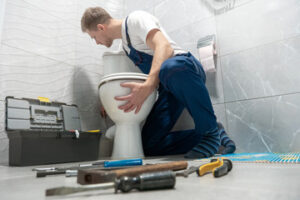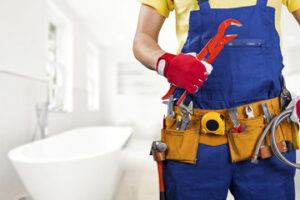Plumbing is the network of pipes and fixtures that deliver fresh water and remove wastewater. It’s a vital part of any home, and proper maintenance is essential to prevent leaks and other problems.

Understanding the basics of plumbing can help you make informed decisions about which materials are best for your home. Visit https://www.plumbing-express.com/ to learn more.
Copper is a natural metal found on Earth that is mined and then used by plumbers to make pipes for homes. It is a great choice for water pipe lines because it is durable and can last for decades with little to no maintenance. However, it is more expensive than other pipe materials like polyethylene and PVC. That is why some homeowners choose to replace their copper pipes with PVC when they do a repipe.
If you are looking for a plumber to replace your copper pipe lines, you should research their qualifications and experience before hiring them. A plumber that specializes in pipe replacement will have the tools and knowledge needed to complete the job quickly and efficiently. The plumber should also be able to offer suggestions on how to keep your home’s pipes in top shape for longer.
The International Plumbing Code is a set of rules and regulations that is used by plumbers to ensure that their work meets standards for safety and health. The code includes guidelines for all aspects of a plumbing system, including the piping that is used. It also covers how to install and repair plumbing fixtures.
A copper pipe line can withstand a lot of pressure without bursting. It is also resistant to corrosion and can withstand high temperatures. It is an excellent choice for hot and cold water plumbing systems. However, a plumber should use caution when installing copper plumbing in older homes. The old piping may be susceptible to galvanic corrosion, which can lead to the release of toxic lead into drinking water.
There are many different types of copper pipes, and each one has its own characteristics. For example, Type K and L copper pipes are thicker than Type M copper pipe. Type K and L pipes are commonly used in residential plumbing for water supply lines. Type M copper pipe is thinner than Type L pipes and is often used in drains, waste, and vents.
Copper is a very good conductor of electricity. It is used in many wires today, and it is more efficient than other metals. In addition to being a good conductor of electricity, copper is also durable and can last for decades without corroding. It is also affordable and easy to install, making it a popular choice for plumbers. Copper is a recyclable metal, so you should always recycle it when you are finished with it. You can find copper recycling centers in most cities and towns.
PolyB
Embrace the adage, “An ounce of prevention is worth a pound of cure.” Taking proactive steps to replace polybutylene pipes before they develop leaks and mold is a sound investment in your property. A comprehensive repiping solution prevents costly plumbing emergencies in your home and ensures that the vital water supply for your family is safe, clean, and fresh.
During the 1970s and 1990s, Poly B was widely used in homes across Canada. Unfortunately, this piping material is prone to failure, especially in areas that experience high temperatures, like hot water pipes or pipes that run through boilers and attics. The resulting cracks, holes, and leaking pipes can lead to costly repairs and extensive plastic water damage, but they also pose serious health risks. These frail pipes leach chemicals into the household drinking water, contributing to a variety of symptoms including headaches and gastrointestinal issues.
Poly B piping also fails to meet modern piping standards, leaving your home vulnerable to contamination from environmental factors and abrasions. Copper, on the other hand, meets these standards and offers superior durability that stands up against the rigours of everyday use.
Aside from enhancing the safety and quality of your water supply, replacing old polybutylene pipes improves your home’s energy efficiency, as these pipes are prone to condensation and heat loss. Using more efficient piping can save on your energy bills, and it can also help you save money on future maintenance expenses.
The first step in identifying the condition of your home’s polybutylene piping is to hire an experienced plumbing service that specializes in repiping. Skilled plumbers can identify the extent of the Poly B problem in your single detached homes, condos, and townhomes in Vancouver and Kelowna, and recommend an efficient repiping strategy that addresses all existing plumbing connections. This streamlined approach reduces installation and repair costs, ensuring that your new plumbing is fully functional and in compliance with building codes. The best part is that repiping with more reliable materials like copper or PEX can also increase your home’s resale value. So what are you waiting for?
Polyethylene
When you’re looking for a pipe line that will carry water, gas or other liquids, it’s important to choose the right type. There are a number of different pipe materials to consider, and each has its own unique set of properties. One popular option is polyethylene (PE).
PE pipes are manufactured from a thermoplastic created from the polymerization of ethylene. This versatile material is often used for water lines and underground utility lines because it’s strong, durable and affordable. It can also be easily recycled.
There are a few different types of PE pipe, including low-density PE and high-density PE (HDPE). Depending on the type you choose, it will be rated for a specific pressure, temperature or other environmental factors.
Low-density PE is commonly used for irrigation systems because it’s flexible and can withstand low pressure. HDPE is more rugged and can handle higher pressure, making it ideal for industrial and commercial piping projects. You can also find PE pipes in heating and cooling systems, as well as geothermal ground loops.
Another benefit of PE pipes is that they’re impermeable, which helps protect environmental water quality in drainage applications. They can also resist damage from rocks and debris in buried lines. PE pipes are also resistant to corrosion and unaffected by soil acidity or moisture. They can even withstand vibration, thermal cycling and extended sun exposure that degrades other plastics.
Polyethylene pipes are also incredibly easy to install. They’re lightweight and flexible, so they can snake around landscaping and contour to placement trenches. They’re also durable, able to withstand crushing and kinking caused by heavy equipment or unforeseen shifting of the earth beneath them. They’re also resistant to chemicals and can withstand freezing temperatures as well as conveying superheated liquids.
Like any piping system, your PE pipe lines will need to be properly insulated. This will help keep the pipes at a safe temperature, prevent surface condensation and provide safety for your personnel. You can use fiberglass or polyurethane insulation, but be sure to choose a material that is rated for the temperatures your pipe lines will encounter.
PVC
PVC pipes are some of the most popular plumbing materials available. They are affordable, durable, water-resistant, and require little maintenance. They are also environmentally friendly, as they use fewer resources to produce than traditional construction materials. This makes them ideal for new construction projects, as well as for replacing older materials in refurbishment projects.
Unlike copper, PVC is not prone to corrosion and can withstand high levels of pressure. This makes it an ideal material for use in a variety of applications, including drainage and sewage systems. PVC is also a safe option for piping drinking water, since it is non-toxic during production.
While there are many benefits to using PVC, there are some things to keep in mind before purchasing this type of piping. First, it is important to know that PVC is not suitable for hot water pipes. Heat and UV can degrade it over time, so it should not be used in outdoor plumbing or to pipe hot water. It is also not flexible, so it should not be used in tight spaces.
Another thing to keep in mind is that there are many types of PVC, and each one has its own unique set of advantages and disadvantages. For example, some types of PVC are not suitable for underground applications, while others are made from recycled materials. Therefore, it is important to research each type of pipe before making a purchase.
The most common type of PVC is uPVC, or unplasticized PVC. This type of piping is typically used for DWV (drainage, waste, and vent) systems in homes and commercial buildings. These pipes are designed to transport wastewater from the building to the city sewer system or an on-site septic tank.
CPVC is an alternative to uPVC for residential and commercial plumbing. This type of piping is manufactured from chlorinated polyvinyl chloride and is designed to handle higher temperatures than other types of PVC. CPVC is commonly used in industrial, chemical, and food and beverage applications. It is also used in fire sprinkler systems and swimming pool plumbing because it is resistant to chlorinated water and high temperatures.

